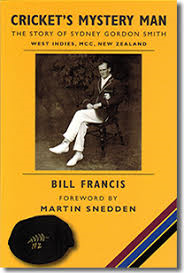Cricket’s Mystery Man
Martin Chandler |Published: 2014
Pages: 97
Author: Francis, Bill
Publisher: The Cricket Publishing Company
Rating: 3.5 stars

It’s an eye catching title, but one that it is not too easy to live up to. The subject is Sydney Smith, a familiar enough name to anyone who takes an interest in cricket history, although they are more likely to be thinking of the man who managed Warwick Armstrong’s 1921 Australian tourists and wrote a very good book about that tour than this contemporary, a man perhaps better known by his initials, ‘SG’.
A top class orthodox slow left arm bowler and more than useful batsman Smith was a white Trinidadian who was the star of the 1906 West Indian tourists, heading both the batting and bowling averages. The previous summer Northamptonshire had joined the County Championship and were struggling. They persuaded Smith to qualify for them and, once he was able to play regularly in 1909 the county went from strength to strength, culminating in finishing as runner-up in 1912, still as good a season as the county have ever had in the Championship.
The county employed SG as Assistant Secretary, a common enough practice in those days, so he could play as an amateur and, in 1913 and 1914, captained the side. He was a fixture for the Gentlemen against the Players, then a recognition of Test quality.
At the end of the 1914 season professional sport ground to a halt in England as sportsmen joined up for the Great War in their droves. SG didn’t however. He packed up his family and moved to New Zealand where he played on until his mid forties. The mystery, such as it is, seems to be why SG left without bothering to tell Northamptonshire? Francis can’t supply the definitive answer to that one, but it seems straightforward enough. As a married man with dependents SG had to do something, and it sounds like he probably had every reason to feel aggrieved at the manner in which Northampton laid him off.
There is one overarching lesson in this book for budding biographers to learn and that is not to pad out their research with tedious descriptions of matches culled from contemporary accounts with just a rudimentary shuffling of the words used by the original writer. Time and again biographies of what I shall describe as ‘lesser’ players founder on that particular error. Francis does, naturally, provide some details of SG’s finest days on a cricket field, but is much more interested in telling the story of his life.
It would not have been difficult for Francis to have expanded this book well beyond its 97 pages by including additional material, but all he would have succeeded in doing would have been diluting the quality of his writing. As it is he gets his page count as far as he does only by including the stories of three other West Indians who spent much of their lives in New Zealand. The stories of the first two, wicketkeeper Sam Guillen,who was capped at Test level by both countries, and batsman Bruce Pairaudeau are dealt with at rather more length than the third, Rudi Webster. Webster, now an eminent sports psychologist, is a man I would have liked to learn more about. His brief First Class career suggests he was a very talented pace bowler, and it is a little disappointing that Francis does not explore his life any further, but then perhaps that is another project he is working on?






Leave a comment